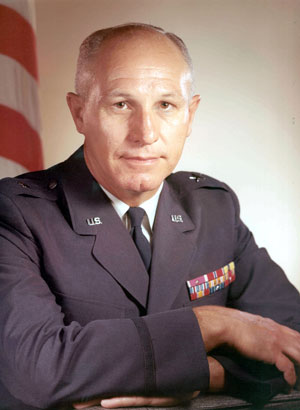Big Sky Ranchby Dwayne Day
|
| King joined a fledgling group of young Air Force officers that was then working on the reconnaissance satellite and who called themselves the “space cadets.” They wore the term as a badge of honor, although their colleagues at Wright-Pat kidded them about working on something as ridiculous as a satellite. |
Back in the 1990s, when the early aspects of America’s satellite reconnaissance program were declassified, I interviewed King and he told me about going to Patrick. There had been a naval air station there during the war, but the Navy had closed it up on war’s end. King’s job was to reopen the facility and prepare it for launching Air Force missiles out over the Atlantic Ocean. It wasn’t pleasant work. Much of it involved wading through swampland, trying to avoid alligators and snakes. King told a story of how he and a sergeant were cutting a road through the swamp: King would walk along a survey line and hold up a large pole. The sergeant would then drive a bulldozer towards the pole. But at one point the sergeant stopped and let out a yell. King came over with the pole and saw that the sergeant was pointing at a large rattlesnake curled up in the weeds. King killed it with the pole and the skin later was mounted on a wall behind a bar in Cocoa Beach (King believed it was Bernard’s Surf restaurant, but another source told me the rattlesnake skin was mounted in another restaurant in town).
In the mid-1950s King went to the University of Chicago where he earned an MBA. When he finished, he was assigned to the Air Research and Development Command (ARDC) at Wright-Patterson Air Force Base as a weapons system project officer for the WS-117L satellite reconnaissance system.
When King went to ARDC he joined a fledgling group of young Air Force officers that was then working on the reconnaissance satellite and who called themselves the “space cadets.” They wore the term as a badge of honor, although their colleagues at Wright-Pat kidded them about working on something as ridiculous as a satellite. They later made up little lapel pins for themselves—possibly the first space pins ever made—showing a satellite path over the Earth. As one of the space cadets later wrote, King was no space cadet, but he knew how to get things done. He was able to use his MBA experience to draw up a plan for the satellite program and to start making progress on selecting a contractor to build it. Lockheed won the contract, but the Air Force wouldn’t allocate any money for it and it was not until after Sputnik that the project finally started receiving funding. King was assigned to the Snark program for awhile during this period, which wasn’t exactly a choice assignment—the cruise missile was experiencing a lot of problems and it was common for those working at Patrick to refer to the “Snark-infested waters” just offshore where so many missiles fell. But soon King returned to the satellite program.
WS-117L expanded into several projects immediately after Sputnik: the Samos film-readout satellite, the Corona film-return satellite, and the Midas missile warning satellite. Samos was overly ambitious and came under increasing criticism by 1959. King apparently defended the program, but by summer 1960 Samos was scaled back because it was incapable of providing the needed reconnaissance on Soviet ICBM sites. Between 1962 and 1966 King served as deputy director of the Office of Special Projects, and his activities there remain classified, although he undoubtedly oversaw the development of the new Gambit high-resolution reconnaissance satellite as well as Air Force signals intelligence satellites.
| The people who work at Cooke have another name for it. They call it Big Sky Ranch. King is saddling up there now. |
In September 1966 King was named commander of the Air Force Satellite Control Facility in Sunnyvale, California. The AFSC was the facility that commanded all of the nation’s intelligence satellites via a series of ground stations around the world. He moved to Andrews Air Force Base in Maryland as assistant deputy chief of staff for operations, Air Force Systems Command. In 1968 King was promoted to Brigadier General and in January 1969 he returned to Los Angeles to serve as assistant to the director of the Office of Special Projects, National Reconnaissance Office. This was also known as Program A in the NRO and it was essentially the Air Force’s branch of the secretive spy agency. He became director of Program A in July, serving in that post until March 1971 when he retired from active duty.
When King commanded the AFSC, the Air Force’s tracking facilities were under his command. One of these tracking facilities is known as Cooke, located at Vandenberg Air Force Base and previously known as Cooke Army Base. The people who work at Cooke have another name for it. They call it Big Sky Ranch. King is saddling up there now.
